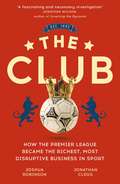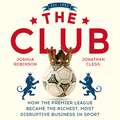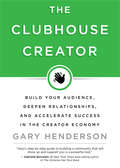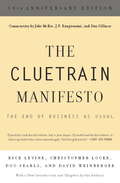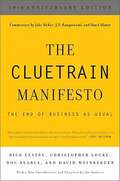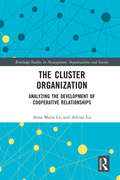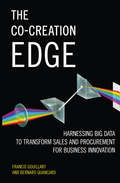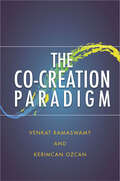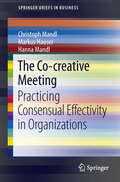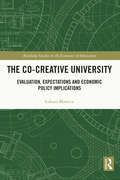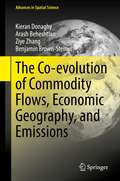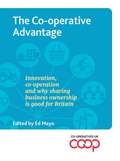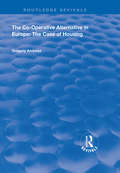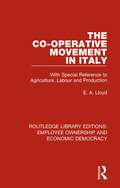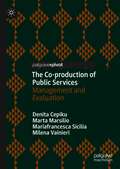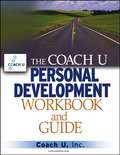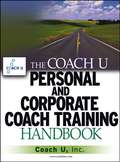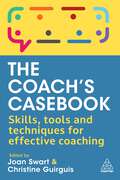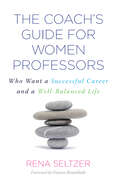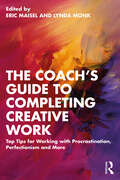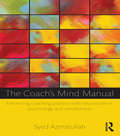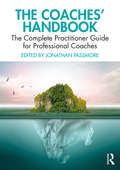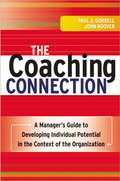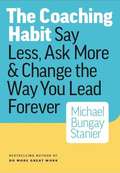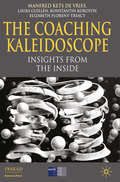- Table View
- List View
The Club: How the Premier League Became the Richest, Most Disruptive Business in Sport
by Joshua Robinson Jonathan CleggAn excellent recap, with wonderful access and forensic detail on the Premier League's rise to global alpha status... All told with an arch sense of humour The GuardianHow did English football - once known for its stale pies, bad book-keeping and hooligans - become a commercial powerhouse and the world's premium popular entertainment?This was a business empire built in only twenty-five years on ambition, experimentation and gambler's luck. Lead by a motley cast of executives, Russian oligarchs, Arab Sheikhs, Asian Titans, American Tycoons, battle-hardened managers, ruthless agents and the Murdoch media - the Premier League has been carved up, rebranded and exported to phenomenal 185 countries. The United Nations only recognizes 193.But the extraordinary profit of bringing England's ageing industrial towns to a compulsive global attention has come at a cost. Today, as players are sold for hundreds of millions and clubs are valued in the billions, local fans are being priced out - and the clubs' local identities are fading. The Premier League has become the classic business fable for our globalised world.Drawing on dozens of exclusive and revelatory interviews from the Boardrooms - including Liverpool's John W. Henry, Tottenham's Daniel Levy, Martin Edwards and David Gill at Manchester United, Arsène Wenger and Stan Kroenke at Arsenal, Manchester City's sporting director Txiki Begiristain, and executives at Chelsea, West Ham, Leicester City and Aston Villa - this is the definitive bustand boom account of how the Premier League product took over the world.
The Club: How the Premier League Became the Richest, Most Disruptive Business in Sport
by Joshua Robinson Jonathan CleggThe never-before-told inside story of how the Premier League became the wildest, richest, most popular entertainment business on the planet.How did English football - once known for its stale pies, bad book-keeping and hooligans - become a commercial powerhouse and the world's premium popular entertainment?This was a business empire built in only twenty-five years on ambition, experimentation and gambler's luck. Lead by a motley cast of executives, Russian oligarchs, Arab Sheikhs, Asian Titans, American Tycoons, battle-hardened managers, ruthless agents and the Murdoch media - the Premier League has been carved up, rebranded and exported to phenomenal 185 countries. The United Nations only recognizes 193.But the extraordinary profit of bringing England's ageing industrial towns to a compulsive global attention has come at a cost. Today, as players are sold for hundreds of millions and clubs are valued in the billions, local fans are being priced out - and the clubs' local identities are fading. The Premier League has become the classic business fable for our globalised world.Drawing on dozens of exclusive and revelatory interviews from the Boardrooms - including Liverpool's John W. Henry, Tottenham's Daniel Levy, Martin Edwards and David Gill at Manchester United, Arsène Wenger and Stan Kroenke at Arsenal, Manchester City's sporting director Txiki Begiristain, and executives at Chelsea, West Ham, Leicester City and Aston Villa - this is the definitive bustand boom account of how the Premier League product took over the world.
The Clubhouse Creator: Build Your Audience, Deepen Relationships, and Accelerate Success in the Creator Economy
by Gary HendersonThe go-to entrepreneurial guide for establishing your platform, building your audience, and monetizing your skills and services on Clubhouse, the audio-only social media app.On a social media app with more than 10 million users and a plethora of dynamic voices jostling for attention, how do you stand out from the noise? How do you draw people to your particular stage, and how do you convert the casual sharing of your unique expertise into a tangible revenue stream?This is the creator economy that we live in, and Clubhouse is the most effective place to organically grow your audience with the most basic of business resources: your networking capability.In The Clubhouse Creator, Gary Henderson, founder of DigitalMarketing.org, reveals his tried-and-true strategies on Clubhouse for:· finding your niche audience· integrating into the flow of social circles and conversations· conveying the value of your goods or services· monetizing your knowledge and expertiseBy using Gary's 7-Figure Clubhouse Funnel, you will be able to generate tangible sales and revenue and establish a core element of your marketing strategy. Now is the time to step fully into an abundance mindset and accelerate your success.
The Cluetrain Manifesto: 10th Anniversary Edition
by Christopher Locke Doc Searls Rick LevineThe Cluetrain Manifesto began as a Web site (cluetrain. com) in 1999 when the authors, who have worked variously at IBM, Sun Microsystems, the Linux Journal, and NPR, posted 95 theses about the new reality of the networked marketplace. Ten years after its original publication, their message remains more relevant than ever. For example, thesis no. 2: "Markets consist of human beings, not demographic sectors”; thesis no. 20: "Companies need to realize their markets are often laughing. At them. ” The book enlarges on these themes through dozens of stories and observations about business in America and how the Internet will continue to change it all. With a new introduction and chapters by the authors, and commentary by Jake McKee, JP Rangaswami, and Dan Gillmor, this book is essential reading for anybody interested in the Internet and e-commerce, and is especially vital for businesses navigating the topography of the wired marketplace.
The Cluetrain Manifesto: The End of Business as Usual
by David Weinberger Christopher Locke Fredrick Levine David SearlsThe book provides a contrast in business and brand promotions from conventional methods to the internet age, where the conversations of connectedness have changed both the business we do, and the way its done.
The Cluster Organization: Analyzing the Development of Cooperative Relationships (Routledge Studies in Management, Organizations and Society)
by Anna Maria Lis Adrian LisCluster organizations are becoming more and more popular, both in developing and developed countries. Considering the development of cluster policy and the related dynamic growth of cluster initiatives in the world, the lack of sufficient knowledge on the development of cooperation in cluster organizations inhibits their development and, in many cases, causes their complete disintegration. The book provides new important elements to the current system of knowledge, filling in cognitive and research gaps in the scientific literature on problems related to cooperation in cluster organizations. The most valuable features for the reader concern the epistemological, methodological, and application aspects. The new element includes a theoretical concept, which refers to the trajectory of development of cooperative relationships in cluster organizations that facilitates the understanding and explanation of mechanisms responsible for cooperation in such organizations. The concept also has great practical advantages, especially for people implementing the idea of "clustering": coordinators, facilitators, and members of cluster organizations as well as politicians and public authorities are responsible for shaping and implementing the cluster policy. It will be of value to researchers, academics, and students in fields with an interest in organizational studies, management of innovation and technology, strategic management, industrial economics, and economic geography.
The Co-Creation Edge: Harnessing Big Data to Transform Sales and Procurement for Business Innovation
by Francis Gouillart Bernard QuancardRapid changes in business along with better informed customers threaten the traditional sales and procurement process. Thousands of sales and procurement people are threatened with extinction, yet all is not destined to be doom and gloom. A new way of partnering between these two roles can, in fact, create significant value for both organizations. Sales and procurement professionals have a bright future ahead of them if they can respond to six trends that the authors have identified in the business-to-business world. Each trend offers an opportunity to develop a new skill for sales and procurement professionals and adopt a new practice. Because these practices are not yet widely adopted as “best practices”, the authors coin them “next practices.” These trends include: working together to solve complex problems; organizing problem-solving networks across company boundaries; creating processes for live cross-company engagement; facilitating data driven, cross-company interactions fed by digital platforms; providing new personal experiences for individuals and lastly (and most importantly) creating new sources of value for firms. If these trends are adopted by organizations, the ability to co-create means providing significant value to both the sales management team at the supplier and the purchasing management team at the customer. With the alternative being that these job functions will be replaced by web-based or channel-based alternatives that will do most of what they do today at a fraction of the cost. Increasingly, there is no middle ground anymore. SAMs and senior buyers will either evolve into high value-added sales and procurement professionals, or disappear.
The Co-Creation Paradigm
by Venkat Ramaswamy Kerimcan OzcanA fundamental shift is underway that will change how we conceive of value. In an era of increasing interconnectedness, individuals, as opposed to institutions, stand at the center of value creation. To adapt to this tectonic shift, organizations can no longer unilaterally devise products and services. They must engage stakeholders#151;from customers and employees to suppliers, partners, and citizens at large#151;as co-creators. Co-creation guru Venkat Ramaswamy and Kerimcan Ozcan call for enterprises to be mindful of lived experiences, to build engagement platforms and management systems that are designed for creative collaboration, and to develop "win more-win more" strategies that enhance our wealth, welfare, and, well-being. Richly illustrated with examples of co-creation in action, The Co-Creation Paradigm provides a blueprint for the co-creative enterprise, economy, and society, while presenting a conceptual framework that will guide organizations across sectors in adopting this transformational approach. Challenging some of our most deeply held ideas about business and value, this book outlines the future of "business as usual. "
The Co-creative Meeting
by Christoph Mandl Hanna Mandl Markus Hauser"Co-creative meetings" foster invention and innovation, and therefore enable innovative developmental processes in an organizational and inter-organizational context, including strategy development, product development, human resource development, R&D, and trans-organizational projects. This book illustrates the difference between productive and innovative organizations and what that difference means for meetings taking place in such organizations, both from a conceptual and practical point of view. It provides managers, coaches, consultants and other professionals whose job it is to organize meetings with clear and action-oriented guidelines for the design of "co-creative meetings", and also shows how to incorporate them through experiential learning.
The Co-creative University: Evaluation, Expectations and Economic Policy Implications (Routledge Studies in the Economics of Innovation)
by Łukasz MamicaThe co-creative university has become the main driver of social and economic development stimulating internal (students and academics) and external creativity (companies and institutional environment) as well as cooperation in various areas (e.g. applied graduation theses, research projects, lifelong learning). Intended as a contribution to a better understanding of how universities create value in numerous areas, this book discusses the determinants of creativity and ways of stimulating it with a special focus on approaches and practical solutions relevant to teaching. Examples include problem-oriented student theses, which represent a successful combination of creativity with practical knowledge. Based on the findings of international surveys of students, the author offers an in-depth analysis of the differences between what they expect from universities and the degree to which their expectations are met. Comparing students’ opinions with those of employees of international corporations (working graduates) permitted the author to test the actual utility of selected aspects of university education. Regrettably, both groups of respondents gave low ratings to support for developing creativity, which should serve as a warning sign and inform future reforms at this level of education. This book is primarily targeted to those involved in education, policy-making, and socio-economic development. It provides a rich source of information for university managers on how to better fulfil their missions based on the idea of co-creativity. It also suggests how to improve the effectiveness of research and education in order to ensure that both can better respond to current development challenges.
The Co-evolution of Commodity Flows, Economic Geography, and Emissions (Advances in Spatial Science)
by Kieran Donaghy Arash Beheshtian Ziye Zhang Benjamin Brown-SteinerThis book presents extensions to current commodity-flow models to analyze the economic and environmental impacts of recent structural changes, such as fragmentation of production and lengthening supply chains. The extensions enable augmented commodity-flow models to analyze the vulnerability of supply chains and regions to climate change and extreme weather events. The models allow the explicit treatment of trade in intermediate goods; the so-called “new economic geography” behavioral foundations for production and inter-industry and interregional trade; endogenous determination of capital investment and employment; and changes in emissions associated with production, consumption and freight movement. Presenting a modeling framework and simulations that are based on a thirty-year, spatial time-series of inter-industry and interstate trade in the US, this unique book is a valuable resource for regional scientists, economic geographers and transportation modelers, as well as environmental and atmospheric scientists.
The Co-operative Advantage
by Edited by Ed MayoIn the wake of the traditional economy, new forms of production are emerging that are characterised by permanent innovation. A multitude of small-scale innovations are down payments on larger transformative possibilities. We can now develop systems of co-operative advantage with small and medium-sized firms to spread innovation. In doing so, we can radically transform the character of education, to be analytical, not informative and to embrace co-operation. We aim not for a marginal increase of equality, but the achievement of a larger life.
The Co-operative Alternative in Europe: The Case of Housing (Routledge Revivals)
by Gregory AndruszFirst published in 1999, this book attempts to understand housing co-operatives in terms of their development over time and their relationships to other types of housing tenure. The book considers them within the framework of the broader co-operative movement and its role in society's overall system of production and exchange. There is an examination of the role of a form of ownership which is neither "private", nor "state" in six countries, and in some cases the fortunes of housing co-operatives seem closely to correlate with periods of political liberalization and crises, heralding a shift in ideological orientation.
The Co-operative Movement in Italy: With Special Reference to Agriculture, Labour and Production (Routledge Library Editions: Employee Ownership and Economic Democracy #4)
by E. A. LloydThis title, originally published in 1925, provides a scientific exploration of some of the forms of co-operative organisation which had attained considerable development in other countries, but were little known to English students of the movement. This account of the co-operative movement in Italy will be of interest to students of economic democracy and economic history.
The Co-production of Public Services: Management and Evaluation
by Mariafrancesca Sicilia Denita Cepiku Marta Marsilio Milena Vainieri"This book provides an excellent guide to the current literature on co-production, with especially valuable attention to its management and evaluation. By highlighting the lessons from co-production in the private sector, the authors give very useful and timely new insights into how co-production can contribute to public services and help to improve public value.”— Tony Bovaird, Professor of Public Management and Policy (Emeritus), University of Birmingham, UKCoproduction covers the practice in which state actors (for example, government agents) and lay actors (for example, members of the public) work together in any phase of the public service cycle. In the past two decades, the literature of coproduction has grown swiftly, but in a fragmented manner. Thus, this book systematizes the literature on coproduction into a comprehensive framework that tackles activation, management and evaluation, illustrated through empirical examples. It adopts a multi-disciplinary approach, analyzing literature streams such as public administration and policy, public management, business management, and marketing, among others. It will be invaluable reading for academics working on coproduction, public management, and business management.
The Coach U Personal Development Workbook and Guide
by Coachinc. Com StaffGet this hands-on training guide to help you launch your coaching career. The Coach U Personal Development Workbook and Guide provides you with the tools you need to build your personal foundation -- preparing yourself to successfully coach others. The detailed and flexible self-assessment lesson plans allow you to set your own pace while engaging in a continuous process of self-awareness and self-improvement. Thousands of people who have completed the personal foundation module have found it helps them to develop the critical tools necessary to become a truly effective and successful coach. As personal and professional coaching continues to prove its benefits to businesses and individuals, Coach U, Inc. , through its Coach U and Corporate Coach U divisions, remains the recognized leader for professional coach training and certification. Founded in 1988, Coach U, Inc. , is the largest provider of online training for individuals interested in entering the fields of personal and professional coaching. Coach U, Inc. , has educated more than ten thousand people, providing them the information, tools, and knowledge they need to successfully enter the fast-growing world of life, career, business, and corporate coaching.
The Coach U Personal and Corporate Coach Training Handbook
by Coachinc. Com StaffThe Most Comprehensive TrainingTool for New and Experienced Coaches Founded in 1988, Coach U, Inc. , is the largest provider of online training for individuals interested in entering the fields of personal and professional coaching. Coach U, Inc. , has educated more than ten thousand people, providing them the information, tools, and knowledge they need to successfully enter the fast-growing world of life, career, business, and corporate coaching. Now, for the first time, Coach U, Inc. , is making its complete course materials available in book form. These provide the basic foundations and training necessary to allow you to take control of your own career; enjoy personal, professional, and financial success; and experience the fulfillment that goes with providing a meaningful service to others. Coach U, Inc. 's unique approach to training encompasses the entire development of the professional coach. From the beginnings of becoming a coach, to all the ins-and-outs of growing a successful coaching practice, this program provides a comprehensive, step-by-step approach to learning how to become a strong, ethical, and dynamic leader in the coaching field. The Coach U Personal and Corporate Coach Training Handbook is the only comprehensive handbook currently available that provides step-by-step training for individuals seeking preparation and certification as a personal or corporate coach. Using the proven Coach U method, this book draws on a multidisciplinary approach to present a complete guide to the business and practice of personal and corporate coaching. This helpful text features: * Detailed coverage of the core skills and methodologies employed in personal and corporate coaching, including a chapter on ethics * Includes coaching scenarios and case studies that demonstrate skills in action * Chapters on marketing and selling your coaching practice and services as well as guidance on practice management As personal and professional coaching continues to prove its benefits to businesses and individuals, Coach U, Inc. , through its Coach U and Corporate Coach U divisions, remains the recognized leader for professional coach training and certification.
The Coach's Casebook: Skills, Tools and Techniques for Effective Coaching
by Joan Swart and Christine GuirguisWhat skills do I need to craft clear and effective coaching questions? How do I set goals for my clients? What do I need to be aware of when coaching with different personalities and facing mental health conditions? The Coach's Casebook answers these questions and provides coaches with a thorough grounding in the knowledge, competencies, tools and techniques they need to coach employees to reach their full potential. This book also explains how these coaching tools and techniques apply in practice to boost personal development, performance and wellbeing.There is extensive coverage of how to apply coaching interventions to manage work-life balance and prevent burnout at work and at home, and how to combine coaching and mindfulness as well as how to encourage clients to develop a growth mindset and reframe imposter syndrome. Specific guidance on active listening, coaching high-performers and those with high-potential, leadership coaching, coaching minorities and underrepresented groups and how to coach challenging personalities is also given. This practical guide, is supported by case studies and scenarios throughout taking from real-life coaching, is for those new to coaching and those in the intermediate stages of their career. The Coach's Casebook contains everything needed to allow clients to flourish.
The Coach's Guide for Women Professors: Who Want a Successful Career and a Well-Balanced Life
by Rena SeltzerIf you find yourself thinking or saying any of the following, this is a book you need to pick up.I know or suspect that I am underpaid, but I hate negotiating. I do everything else first and then write in the time left over.I’m not sure exactly what the promotion requirements are in my department.Since earning tenure, my service load has increased and my research is suffering. I don’t get enough time with my family.This is a practical guide for women in academe – whether adjuncts, professors or administrators – who often encounter barriers and hostility, especially women of color, and generally carry a heavier load of service, as well as household and care responsibilities, than their male colleagues. Rena Seltzer, a respected life coach and trainer who has worked with women professors and academic leaders for many years, offers succinct advice on how you can prioritize the multiplicity of demands on your life, negotiate better, create support networks, and move your career forward. Using telling but disguised vignettes of the experiences of women she has mentored, Rena Seltzer offers insights and strategies for managing the situations that all women face – such as challenges to their authority – while also paying attention to how they often play out differently for Latinas, Black and Asian women. She covers issues that arise from early career to senior administrator positions. This is a book you can read cover to cover or dip into as you encounter concerns about time management; your authority and influence; work/life balance; problems with teaching; leadership; negotiating better; finding time to write; developing your networks and social support; or navigating tenure and promotion and your career beyond.
The Coach's Guide to Completing Creative Work: Top Tips for Working with Procrastination, Perfectionism and More
by Eric Maisel Lynda MonkThis book brings together 38 creativity coaches from around the world to offer coaches, therapists, creatives and clients accessible and practical tools to get their creative work done. Curated by two leading creativity coaches, these chapters seek to help coaches and clients alike tackle common challenges that all creatives face when finishing a project. Chapters cover topics such as procrastination, failure, accountability, perfectionism, mindfulness, the importance of support, perseverance and more, with each section finishing with tips for both clients and coaches that can be used in sessions. Filled with rich case studies and true stories from creativity coaches throughout, this book addresses the current issues of our times, such as the distractions of social media, remote working and the effects of the COVID-19 pandemic. Applicable to a range of creative disciplines, this book is essential reading for coaches, therapists and their creative clients looking to complete their creative work efficiently and effectively.
The Coach's Mind Manual: Enhancing coaching practice with neuroscience, psychology and mindfulness
by Syed AzmatullahThe Coach’s Mind Manual combines the latest findings from neuroscience, psychology, and mindfulness research to provide an accessible framework to help coaches and leadership development specialists improve their awareness of the mind, enhancing their coaching practice. Syed Azmatullah explains how such knowledge can be used to guide clients on a journey of self-discovery, facilitating transformational changes and enriching their performance and personal lives. Part One considers the mind’s management committee, the cerebral cortex, and how its contrasting functions can be accessed to improve problem solving skills. Part Two considers the mind’s middle management, the limbic system, balancing executive direction with our social and emotional needs, driving motivation around core values. Part Three examines how the environment, via the body, influences our mental infrastructure at various stages in life, guiding the selection of interventions. Part Four looks at interpersonal dynamics and how to maximise team performance. Part Five considers the power of collaboration for generating the culture needed to improve the sustainability of our global community. Each section contains self-reflection exercises and experiential role-play to help clients derive benefit from their new personal insights. Coaches are encouraged to combine the broad range of concepts presented with their own experience, creating a contextually-driven coaching process. By focusing on the mind as the target for coaching interventions Azmatullah establishes a comprehensive framework for achieving transformational change. The Coach’s Mind Manual is ideal for all professionals engaged in adult development including executive coaches, business coaches, human resource development professionals, leadership development professionals, management consultants and organisational development professionals.
The Coaches' Handbook: The Complete Practitioner Guide for Professional Coaches (Wiley-blackwell Handbooks In Organizational Psychology Ser.)
by Jonathan PassmoreThis comprehensive practitioner guide provides an accessible evidenced based approach aimed at those new to coaching and who may be undertaking coach training for a certificate in coaching or professional credentials or accreditation with the AC, ICF, EMCC, CMI or ILM. The book will also be useful for those who want to enhance their coaching skills. The Coaches Handbook is edited by Jonathan Passmore, an internationally respected expert and executive coach, with chapters from leading coaching practitioners from across the world. The book is divided into seven sections. Section one examines the nature of coaching, its boundaries, the business case for coaching and how organisations can build a coaching culture. Section two focuses on deepening our self-understanding and understanding our clients, the non-violent communications mindset and the coaching relationship. Section three focuses on the key skills needed for coaching including goal setting, powerful questions, active listening, using direct communications and the role of silence, emotions and challenge in coaching. Section four offers a range of coaching approaches including behavioural, person-centred, solution-focused, psychodynamic, neuroscience, narrative, positive psychology, out-door eco-coaching, team coaching, careers coaching and integrated coaching. Section five focuses on fundamental issues in coaching such as ethics and contracting and evaluation. Section six explores continuous professional development, reflection and the role of supervision, as well as how to establish your coaching business. The final section contains a host of coaching tools which practitioners can use to broaden their practice. Unique in its scope, this key text will be essential reading for coaches, academics and students of coaching. It is an important text for anyone seeking to understand the best practice approaches that can be applied to their coaching practice, including human resources, learning and development and management professionals, and executives in a coaching role.
The Coaching Connection: A Manager's Guide to Developing Individual Potential in the Context of the Organization
by John Hoover Paul GorrellTraditional coaching methods have focused entirely on the individual--sometimes even at the expense of improving measurable business results for the company. Now, authors John Hoover and Paul J. Gorrell, both notable leaders and talent experts, show managers how they can use contextual coaching to ensure both individuals and organizations experience the highest probability for success. Contextual coaching uses a dual-focus systems approach to align coaching processes with the strategies, cultural imperatives, talent management systems, communication practices, and competency requirements of an entire organization. The Coaching Connection teaches readers how to apply this methodology by taking all of these factors into consideration within their own organizational context. When coaching initiatives are successful, individual and organizational interests become one. Including a 360-degree assessment covering the ten most essential skill sets of well-balanced and effective leaders, as well as systems for measuring and managing talent, The Coaching Connection helps companies improve both their people--and their bottom line results.
The Coaching Habit: Say Less, Ask More & Change the Way You Lead Forever
by 978-0-9784407-4-9A fresh innovative take on the traditional how-to manual, the book combines insider information with research based in neuroscience and behavioural economics, together with interactive training tools to turn practical advice into practiced habits. Witty and conversational.
The Coaching Kaleidoscope
by Elizabeth Florent-Treacy Manfred Kets De Vries Laura Guillen Konstantin KorotovThrough sharing the research methodologies, and describing intervention and change techniques used in leadership development, this book, written by IGLC-INSEAD professors and leadership coaches, contributes to a better understanding of how organizations may go beyond coaching in order to create best places to work.
